Fgf21 regulates T-cell development in the neonatal and juvenile thymus
- PMID: 28336912
- PMCID: PMC5428243
- DOI: 10.1038/s41598-017-00349-8
Fgf21 regulates T-cell development in the neonatal and juvenile thymus
Abstract
We have previously shown that Fibroblast growth factor 21 (Fgf21) is expressed in the thymus as well as in the liver. In line with this expression profile, Fgf21 was recently reported to protect against ageing-related thymic senescence by improving the function of thymic epithelial cells (TECs). However, the function of Fgf21 in the juvenile thymus remained to be elucidated. We investigated the physiological roles of Fgf21 in the juvenile thymus and found that young Fgf21 knockout mice, but not β-Klotho knockout mice nor adult Fgf21 knockout mice, showed a significant reduction in the percentage of single-positive CD4+ and CD8+ thymocytes without obvious alteration in TECs. Furthermore, treatment with recombinant FGF21 protein rescued the impairment in fetal thymus organ culture (FTOC) of Fgf21 knockout mice. Annexin V staining revealed FGF21 protein enhanced apoptosis of immature thymocytes undergoing selection process in FTOC, suggesting that FGF21 may facilitate the selection of developing T cells. Endocrine Fgf21 from the liver induced by metabolic stimulation did not affect juvenile thymocyte development. Our data suggest that Fgf21 acts as one of intrathymic cytokines in the neonatal and juvenile thymus, involving thymocyte development in a β-Klotho-independent manner.
Conflict of interest statement
The authors declare that they have no competing interests.
Figures
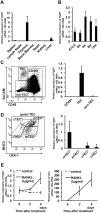
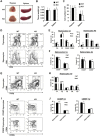
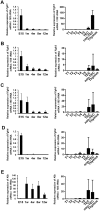
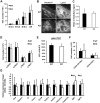

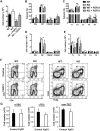
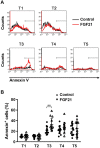

Similar articles
-
Thymic Epithelial Cell Support of Thymopoiesis Does Not Require Klotho.J Immunol. 2018 Dec 1;201(11):3320-3328. doi: 10.4049/jimmunol.1800670. Epub 2018 Oct 29. J Immunol. 2018. PMID: 30373854 Free PMC article.
-
Regulation of thymic epithelium by keratinocyte growth factor.Blood. 2002 Nov 1;100(9):3269-78. doi: 10.1182/blood-2002-04-1036. Blood. 2002. PMID: 12384427
-
Enhanced paracrine action of FGF21 in stromal cells delays thymic aging.Nat Aging. 2025 Apr;5(4):576-587. doi: 10.1038/s43587-025-00813-5. Epub 2025 Feb 19. Nat Aging. 2025. PMID: 39972172 Free PMC article.
-
Control of the thymic microenvironment by growth hormone/insulin-like growth factor-I-mediated circuits.Neuroimmunomodulation. 1995 Nov-Dec;2(6):313-8. doi: 10.1159/000097210. Neuroimmunomodulation. 1995. PMID: 8840333 Review.
-
Cellular and molecular interactions of thymus with endocrine organs and nervous system.Cell Mol Biol (Noisy-le-grand). 2001 Feb;47(1):103-17. Cell Mol Biol (Noisy-le-grand). 2001. PMID: 11292245 Review.
Cited by
-
A review of fibroblast growth factor 21 in diabetic cardiomyopathy.Heart Fail Rev. 2019 Nov;24(6):1005-1017. doi: 10.1007/s10741-019-09809-x. Heart Fail Rev. 2019. PMID: 31175491 Review.
-
Fibroblast growth factor 21: a regulator of metabolic disease and health span.Am J Physiol Endocrinol Metab. 2017 Sep 1;313(3):E292-E302. doi: 10.1152/ajpendo.00101.2017. Epub 2017 May 30. Am J Physiol Endocrinol Metab. 2017. PMID: 28559437 Free PMC article. Review.
-
Progress on methods of T lymphocyte development in vitro.Zhejiang Da Xue Xue Bao Yi Xue Ban. 2022 Aug 1;51(4):491-499. doi: 10.3724/zdxbyxb-2021-0369. Zhejiang Da Xue Xue Bao Yi Xue Ban. 2022. PMID: 37202105 Free PMC article. Review. English.
-
Paracrine FGF21 dynamically modulates mTOR signaling to regulate thymus function across the lifespan.Nat Aging. 2025 Apr;5(4):588-606. doi: 10.1038/s43587-024-00801-1. Epub 2025 Feb 19. Nat Aging. 2025. PMID: 39972173 Free PMC article.
-
Modulation of the Systemic Immune Response in Suckling Rats by Breast Milk TGF-β2, EGF and FGF21 Supplementation.Nutrients. 2020 Jun 24;12(6):1888. doi: 10.3390/nu12061888. Nutrients. 2020. PMID: 32599899 Free PMC article.
References
Publication types
MeSH terms
Substances
LinkOut - more resources
Full Text Sources
Other Literature Sources
Molecular Biology Databases
Research Materials

